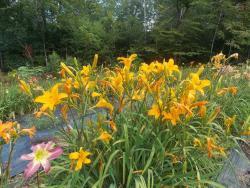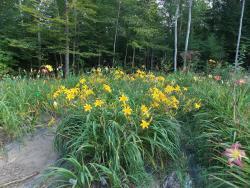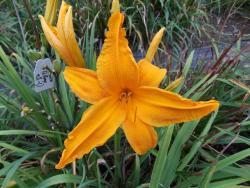Maurice,
They grow GREAT. I told someone who was scouting for Oakes Daylilies that I couldn't believe everyone didn't want a piece of Volcan Fuego. Such a great color - as you know, it's a cross of H. Hak x Burning Daylight from the 1950s and BD, with its barely perceptible paprika red really makes this glow. Plus it has H. Hak's phenomenal (5-6-way) branching, and bud counts (25-40). I have quite a few of Brian Mahieu's plants, and this is by far the best performer.
The pic below of Volcan Fuego was taken August 14, 2014. I originally got this as a DF in 2012. Plus, I had sold some out of it before this pic was taken. You can see it still has quite a few buds, and goes well into September. It's always a trick to get ripe pods off it before the weather gets too cold.
The pic of H. Hakuunensis was taken on September 2, 2015. It blooms right til late September. (My peak bloom is roughly third week of July through first or second week of August.)This started with probably 6 clumps of 4F each in 2013. It increases very well, I'm always selling clumps out of it and it comes right back. I've counted seven branches and 50 buds on some scapes. Also, BTW, it sets bee pods like crazy. Query whether the bees are pollenating it with itself and it lacks the incompatibility rejection mechanism, or whether the bees are bringing pollen from other plants.
They're both fully dormant here.
VOLCAN FUEGO:

H. Hakuunensis:

Just FYI, here's BURNING DAYLIGHT - really glows in the garden. This was taken Sept 10, but it was one of the very last blooms (or maybe even a rebloom; I don't remember):



